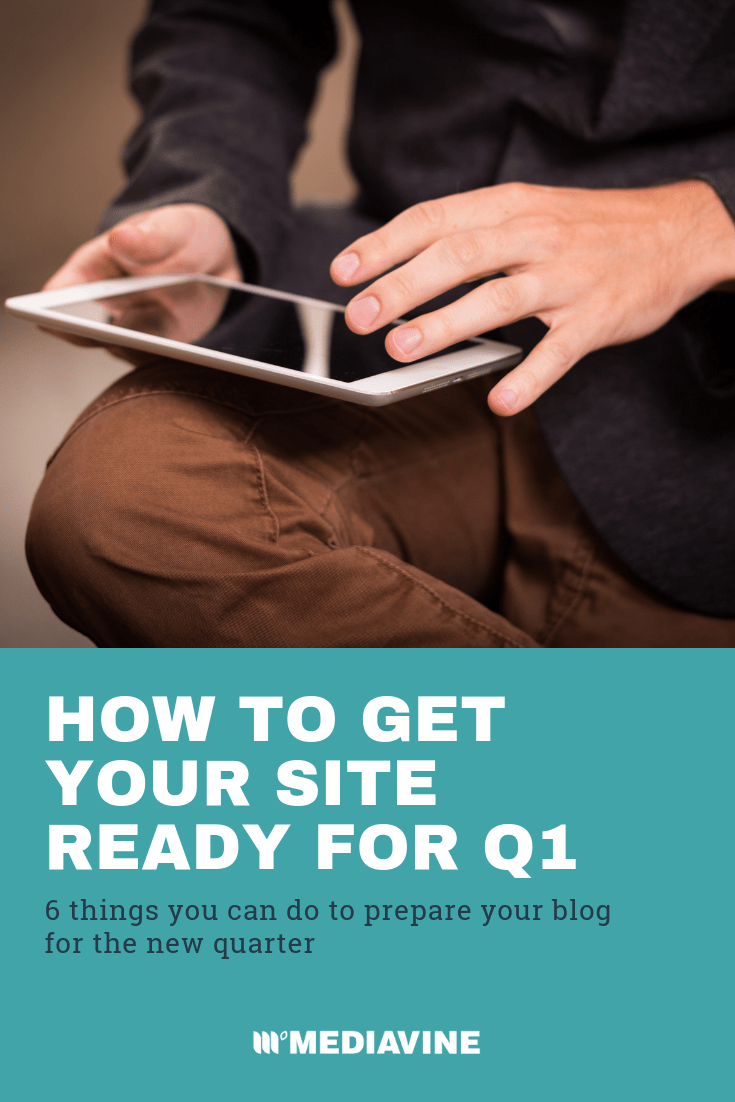- Increasing RPM
Get Your Site Ready for Q1
•

Why does ad revenue go down in January?
The first few days of any month typically see low advertising spend, because advertisers are still deciding how and where they will spend that month, and it’s very normal for RPMs to drop on those days. When that month is also the beginning of a new quarter, like January, April, July or October, that drop is a little more drastic. And when a month is also the start of a new year (AKA January)? That RPM drop can be really big, especially when you compare it to the magically high RPMs of Q4. January’s drop is much larger because advertisers are making their plans for the new month, quarter and year as a whole. As a blogger myself, I can tell you that January hurts. But you CAN make it hurt less. How? I’ll tell ya!
How do you make Q1 hurt less?
We’ve got a whole host of resources to help you boost your RPM. Before Q4, we encouraged you to take the Content Upgrade Challenge, our three-week guide to optimizing your top posts to set you up for a great quarter, and you can do the same for Q1. And Q2 and Q3 and next Q4… Our co-founder and CEO Eric Hochberger has been focusing on ways to increase RPM with his weekly Go For Teal video series and blog posts. Each week, he’s been sharing a new tip, and we’ve rounded them up for you along with even more resources we have created for you.
1. Make simple changes to the design of your site.
There are things you can do with your theme, site layout and typography to help you boost your RPM. Things like increasing font size and adjusting line height can make a big difference as to how your in-content ads will perform. If you can shorten your sidebar, your sticky sidebar ad can earn even better. Employ the help of a heat map plugin to help you decide what to cut. Use your dashboard health checks to help you decide if you should make some of these changes to your site.
2. Lengthen your top articles.
For ads, longer content will perform better than a shorter post. For instance, how many images you embed and how many words you write affect how many in-content ads will show in your posts. Adding more words and images to your top posts — the ones with the most traffic, and potential ad revenue — can be a direct benefit to your bottom line. Your top posts from last Q1 are a great place to start. Check out Week 1 of the Content Upgrade Challenge to learn how to identify those posts in Google Analytics so you can decide which posts to optimize first.
3. Adjust the formatting of your top posts.
The way you format your articles can have an impact on how your ads perform, too. Short sentences and succinct web-friendly paragraphs are the way to go, because more line breaks help with in-content ad placement, which helps to increase RPM. It’s also great for user experience on mobile. Breaking up paragraphs with headings is not only helpful for your reader, but it’s great for SEO. And it makes your blog posts even longer. (See point #2 above.) Lastly, make sure you are putting the “focus” of your post at the end. This could be a recipe or how-to card like Create by Mediavine®, a video or printable. Whatever it is that readers will want to know when they arrive at your post. When you place your most valuable content at the end of a post, it encourages readers to scroll all the way to the end, past all of your ad placements. And that yields more money and higher RPMs for you.
4. Check your dashboard settings.
The settings you have in your dashboard can definitely make an impact on your RPM and overall ad revenue. Your in-content ad frequency settings are a huge part of this, because they dictate how many ads your posts will get. With our in-content ad logic, you can adjust ad density, change the spacing between ads and set limits to the overall number of ads for both desktop and mobile. We covered all of this a little more in-depth in Week 2 of the Content Upgrade Challenge, where we guide you through how to complete an ad audit. This is a great way to make sure you are running all the ads you should be, and we’re always on hand at publishers@mediavine.com to help.
5. Utilize Mediavine’s video capabilities.
Mediavine offers several video capabilities that you definitely should be taking advantage of, especially now that we’ve unveiled the Up Next feature. Our embedded video player makes it easy to embed videos (with pre-roll ads). Our sticky desktop video and mobile video adhesion units are great ways to engage users with your videos while they read your content. With both, the video “sticks” with the reader as they scroll, and you’ll earn from the pre-roll ads that play before them. We’ve even gotten feedback that these “don’t feel like ads,” which is awesome for user experience. Don’t have any videos yet? No worries! Learn how to make a featured video with Animoto. All you need is one video file uploaded to your dashboard to enable these units, so hop to it!
6. Work on your page speed.
How fast your site is has a direct relationship to your RPM and your traffic. Why? Readers don’t like slow sites. In fact, they’re more likely to click away from a site if it takes too long to load. And if a reader doesn’t stick with your article for very long? They’re not going to see very many of your ads. At Mediavine, everything we do is with page speed in mind, because it plays such a big role in SEO. Page speed is driving development decisions across the web, so search engines and even social media sites like Pinterest are more likely to prioritize faster websites in search results. Our ads are lazy-loaded which means they aren’t there at all until a reader scrolls near them. We also load our script wrapper asynchronously, which means your ads wait until everything else on the page has loaded. If other plugins or things like images are slowing your site down, it can mean that readers miss out on seeing some of your ads. Head to Google PageSpeed Insights to see what the scores of your top posts are, then get to work on fixing anything you can by following these tips. We also recently introduced a dashboard setting to optimize ads for mobile page speed and one for desktop pagespeed as well. We recommend working on a plugin self-audit and putting into place an image optimization tool like Short Pixel to help you increase those page speed scores.
Can I do more to increase my RPM?
Yes, always! Everything we listed here are checklist items you can revisit time and time again. I find that for my own site, there are always things I can tweak and rework. RPM isn’t really ever ‘done’ — it’s a continuous process. Last summer, two of our publishers, Aimee Shugarman of Shugary Sweets and Courtney O’Dell of Sweet C’s Designs, joined Marketing Manager Jenny Guy for an episode of our Summer of Live. They shared all about their strategies for unlocking RPM that you can enact, too. Our Content Upgrade Challenge is also always online to help you optimize your top posts and get prepared ahead of each quarter. Taking the challenge now, ahead of Q1, can set you up for a great quarter and make that RPM drop hurt less. Our Facebook group for our MVPs is also a great resource for collaborating with other publishers and getting ideas. If you’re not a member yet, you can request to join. (Don’t forget to answer the questions!) And no matter what, remember that Q1 is only a few short weeks, and February will be better than January, and March will be better than February. The third month in the quarter is typically the best. It’ll be spring before you know it, with better Q2 earnings ready to shower you!About the author
Share this page